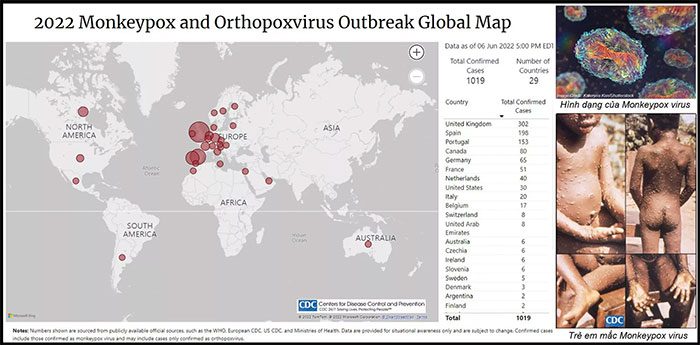To date, the number of confirmed monkeypox cases has exceeded 1,000 and has appeared in 29 countries, primarily concentrated in Europe. Is there a possibility that it could become a dangerous pandemic in the future, and what should humanity do to prevent it?
Can Monkeypox Become a Pandemic?
Monkeypox is a disease that, based on its host characteristics, transmission rate, and virulence, is not considered overly dangerous or alarming. However, the recent “unusual” phenomenon of infection involving a large number of people and its widespread occurrence has prompted health authorities in various countries to take “careful” measures.
There remains a possibility that the virus strain could mutate and create a new, “more dangerous” variant than the previous one. Therefore, it is essential to prepare necessary preventive measures, including stockpiling a sufficient amount of smallpox vaccine (at least enough to vaccinate healthcare workers).
High-risk groups for this disease include individuals with immunocompromising conditions, children (under 8 years old), pregnant or breastfeeding women, and those with underlying conditions related to skin infections, gastrointestinal infections, or respiratory infections, as they may experience severe symptoms and require treatment with antiviral medications, antibodies, and other medical support.
Can Smallpox Vaccine Be Used to Prevent Monkeypox?
Before discussing monkeypox, we should recall a closely related disease known as “Smallpox”, which was a nightmare for humanity due to its high transmissibility and a mortality rate of about 30%.
This disease has ancient origins, found in Egyptian mummies over 3,000 years old or recorded in China from the 4th century AD. It is caused by the variola virus, which is approximately 200 nm in size and has a double-stranded DNA genome. In classification, it belongs to the Orthopoxvirus genus.
This disease is also linked to the history of vaccine development in humans. It was observed that exposing healthy individuals to “material” from healed smallpox lesions—either by rubbing it on the skin or inhaling it—could induce mild illness and reduce mortality rates from smallpox.
In 1796, Edward Jenner, an English physician, noted that milkmaids who contracted mild diseases from cowpox were immune to smallpox. This observation laid the groundwork for vaccine development using the cowpox virus, later named vaccinia, to prevent smallpox.

Monkeypox shows no signs of stopping.
Thanks to the development of this vaccine, smallpox in humans was rapidly eradicated. By 1980, the World Health Organization (WHO) declared this virus “extinct” on Earth. Vaccination campaigns are no longer necessary in most places, meaning that anyone born after 1980 typically does not need to be vaccinated against smallpox (some places, like the US, stopped before that, in 1972, and the UK in 1971).
Currently, only two locations in the world store frozen smallpox virus strains for research purposes: Atlanta, USA, and Novosibirsk, Russia.
Returning to the recent monkeypox outbreak, the monkeypox virus is also a close relative of the smallpox virus, belonging to the same Orthopoxvirus genus.
However, monkeypox has some significant differences from the smallpox virus:
1. The natural host of monkeypox is animals, particularly rodents in Africa and some species of monkeys. This virus rarely infects humans. The first human case was recorded in 1970 in the Democratic Republic of the Congo, followed by sporadic cases in other African countries. Some cases outside Africa, such as in the USA, Singapore, Israel, and the UK, were linked to travelers or imported animals from Africa.
2. Compared to human smallpox, monkeypox presents similar symptoms such as fever, headache, fatigue, muscle aches, and skin lesions, but the severity is milder. The mortality rate for monkeypox ranges from 1% to 15%, while smallpox has a mortality rate of about 30%.
3. Monkeypox primarily spreads from animals to humans, with the usual hosts being rodents (mice, squirrels, prairie dogs). Human-to-human transmission remains very limited at this time.
Currently, to prevent the spread of the monkeypox virus in outbreak areas or among individuals who work with potential sources of infection, smallpox vaccines are being used. Because these two viruses are closely related, the smallpox vaccine can provide approximately 70-85% protection against monkeypox.
While it is not yet necessary to use this vaccine widely, in the worst-case scenario, it could be utilized to combat the spread of this virus within communities.



















































